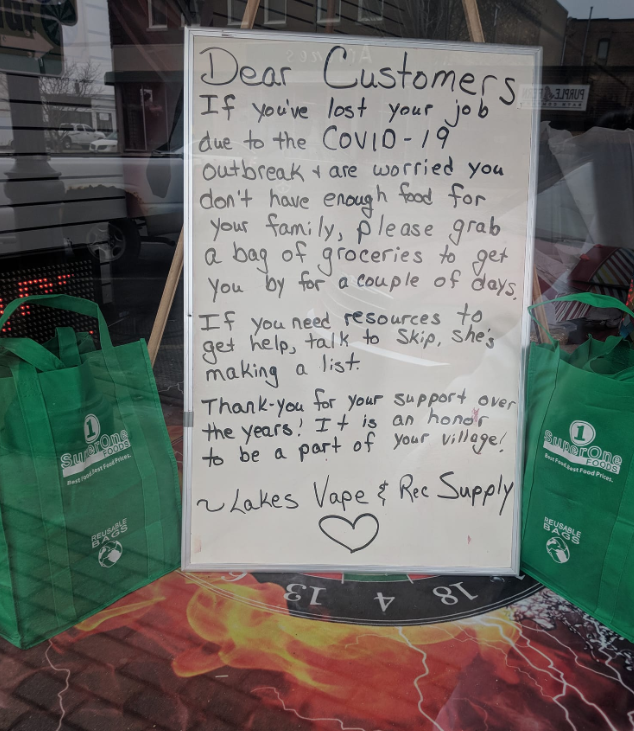There’s an oversimplified notion that only Big Tobacco supports vaping. On the contrary, thousands of small businesses, selling vapor products manufactured by small companies, are the backbone of tobacco harm reduction in the United States. Until recently, I ran one of them.
Much of my family smoked cigarettes. After a heart attack at age 29, my son switched to vaping. He then opened a vape shop in Brainerd, a small town in Minnesota, to help others quit smoking. That included me; I was his first accidental quitter. We both quit smoking using a rainbow sherbet flavor.
I took over ownership of the shop in 2018, and we found it rewarding to help others quit smoking. For example, a woman with COPD tried vaping through us after her doctor recommended it. He, unlike many physicians, understood that nicotine is not the cause of most smoking-related harms. As a result, she quit smoking with a mixed-fruit-flavored e-liquid. She told us, “I think you saved my life!”
After a flood of government-sanctioned disinformation, I witnessed customers returning to smoking.
Most adults who vape prefer fruity flavors. To become smoke-free, they do not want to use products that taste like cigarettes. One of my favorite regulars was a gruff military veteran who refused to vape anything other than mango flavor, referring to his vape as his “puffing machine.”
Our own experiences of smoking and vaping, as well as our personal connection with the community, helped us give tailored advice to our customers—guiding them in finding the devices, flavors and nicotine levels that worked best for them to leave smoking behind. People often try a few options before settling on the right one, and the answer is different for each person.
A father quit smoking by vaping a strawberry-flavored e-liquid because his daughter had asthma. She was told at school that people using vapor products get “popcorn lung” and die. She begged her dad to return to smoking. Leading experts debunked that myth years ago. Still, some sources continue to disseminate the falsehood.
In 2019, after a flood of government-sanctioned disinformation about the outbreak of lung injuries wrongly termed “EVALI,” I witnessed customers returning to smoking. Vitamin E acetate, an additive used in some illicit THC cartridges, has long been established as the cause of EVALI. However, the media, the Centers for Disease Control and the Food and Drug Administration (FDA) all made statements that led people to believe regulated nicotine vapor products were the culprits—a misperception that persists today.
In 2020, during state-mandated COVID lockdowns, I saw more adults light up after years of being smoke-free. Vape shops were closed, while cigarettes, which kill 480,000 Americans annually, remained available everywhere. There was no level playing field for reduced-risk products.

Being a vape shop owner became increasingly frustrating. I watched moral panic, misinformation, and overly burdensome regulations erode my ability to help adults quit smoking. The public is not informed about the risk continuum among nicotine products—leaving adults who smoke convinced that vaping is equally or more harmful than smoking, and destroying the chance of them trying a safer alternative.
The FDA’s task is to regulate vapor products, weighing the risks and benefits according to the statutory standard of “appropriate for the protection of public health.” Citing youth concerns, the FDA has denied the applications for millions of flavored vaping products. Yet those applications were for products used overwhelmingly by adults—the very products I once carried in my shop to help people stop smoking.
I am reminded of the great-grandma who vaped our cotton candy-flavored products. What kept her from returning to smoking is no longer legal.
Meanwhile, the few vapor products that have received “marketing granted” orders from the FDA are tobacco-flavored, and manufactured by large companies with the resources to meet hugely onerous application requirements.
I am reminded of the great-grandma who vaped our cotton candy-flavored products to quit smoking. What kept her from returning to smoking is no longer legal, while lethal combustible cigarettes are still available everywhere.
The regulatory process needs balance. Youth vaping can be curbed while helping adults stop smoking. Age restrictions should be mandatory, including for online sales. Retailers should be licensed, with licensing fees covering the expense of compliance checks. Retailers who repeatedly fail compliance checks should lose their licenses. And regulators should clearly define marketing, manufacturing and ingredient standards.
Policymakers ought to take these reasonable steps to avoid outlawing vapor products, which would only incentivize more cigarette smoking. A variety of reasonably regulated products will help achieve the priority goal of ending smoking. Unfortunately, almost complete prohibition appears to be the direction the FDA is taking.
My shop served members of populations with the highest smoking rates: people with low incomes and limited formal education, veterans, seniors and neurodivergent people. But in December 2021, after a 60 percent decline in sales, I informed my customers I was closing. I felt like I was letting them down.
Many other small shops serving communities in need have also shut down or are under threat. Losing vape shops, often in places without other sources of tobacco harm reduction, means people who smoke lose the agency to choose a more desirable, less harmful path. They lose the personal support that empowers them to quit smoking. And the whole country loses momentum to help people stop smoking and save their lives.
The passion and lived experiences of vape shop owners and staff can help drive the consumer-grounded solution to our crisis of smoking deaths—but only if society lets us.
Photographs of shop window courtesy of Kim “Skip” Murray





Show Comments